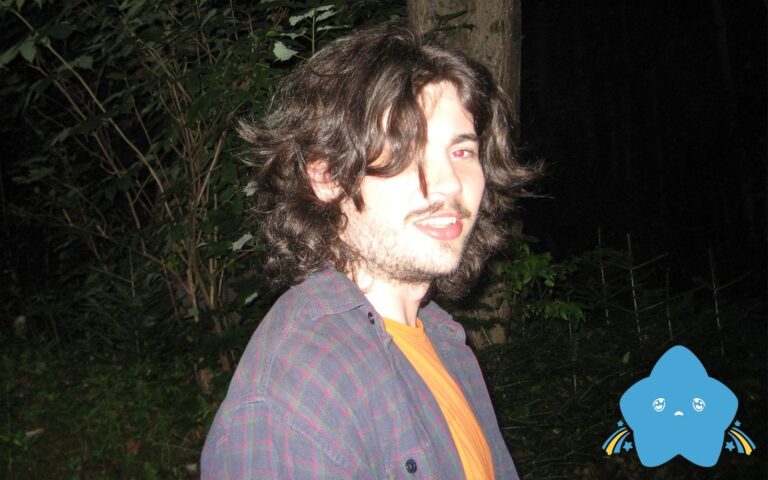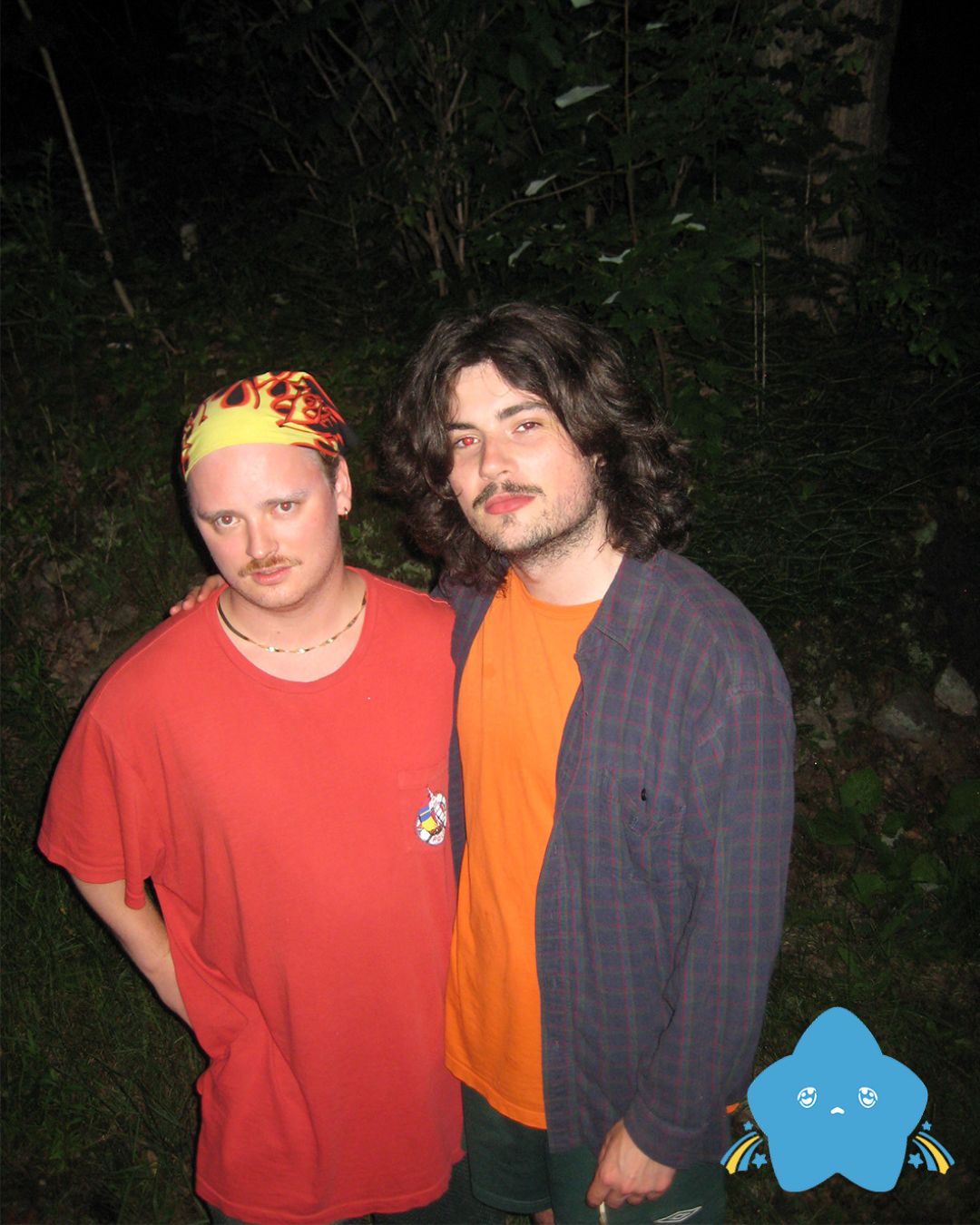By Stephan Boissonneault
With There Is Nothing In The Dark That Isn’t There In The Light, the veteran vocalist leans into intimate, searching folk.

Emanating nostalgia through an infectious blend of ’80s-inspired synths, husky guitar, and glossy vocals comes Ura Star, the solo endeavour of New Brunswick transplant Seth O’Neill. The former bassist of the St. John indie rock outfit Stegosaurus is now stepping into his new role as a would-be heartthrob in the middle of Montreal’s underground scene.
Although O’Neill has taken a definitive step into the limelight, he’s not entirely alone. Collaborating once again with long-time creative partner Fireball Kid, Heartracer marks the third instalment in a run of albums exploring themes of friendship, romance, and the electric energy of party life. Together, Ura Star and Fireball Kid have refined their dynamic into a seamless fusion of audio-visual fidelity, building a wall-of-sound style filled with overdriven guitars and glittering synths. Their partnership, which began in their early days jamming in the Maritimes, has evolved into a powerful creative force, pushing each other to new heights.
The album’s lead single, “I’m Searching for a Pure Kind of Love,” exemplifies this synergy, blending heartfelt emotion with playful visuals that draw listeners into Ura Star’s vibrant, neon-lit world. The accompanying music video captures Ura Star’s signature blend of playful nostalgia and DIY charm.
RANGE Magazine caught up with O’Neill to talk about Heartracer’s arrival, developing an alternative persona, and the roots he still holds onto.
You transitioned from playing bass in indie rock bands like Stegosaurus to fully embracing synth-pop. What was it about this genre shift that felt right for you at this stage in your musical career?
I learned so much from being Stegosaurus and running around performing the Atlantic Canadian bar circuits. Working with Stuart, Colin and Pat taught me how to find my niche in group collaboration and invaluable experience in jamming songs out until they work. After my time in Stegosaurus ended, I didn’t really have my own sense of identity as a songwriter or creative and in classic New Brunswicker-in-their-late-teens fashion decided to completely remove myself from my hometown environment and move to the city to pursue music. I think this change of environment manifested in – or at least contributed to – a genre pivot. You can’t help but be influenced by the culture around you and being away from home, it just felt right to be trying to do something different than what I was used to. To be honest, I also just really wanted to sing, which has always been my first love and favourite thing to do.
Heartracer is described as the capstone to a trilogy of albums. Can you tell us more about the thematic thread that ties these three works together, and how Heartracer completes that journey?
The three albums in tandem broadly represent Colin (Fireball Kid) and I pursuing a sound of energy and pushing it as far as we could. With booming, chanty group vocals, overdriven melodic guitar solos and the like, we just set out to make maximalist, wall-of-sound, full-speed music. Thematically, Emotional Bros Hotline, Gas Station, and the final piece to the trilogy, Heartracer, encompass vulnerable earnestness, community, communication, romance with friends, and party life. Heartracer as a capstone takes the yearning, romance, and love of friends to an over-the-top and crystallized level.
Your sound has been called a blend of “maudlin songwriting with shiny synths and husky guitars.” What inspired this signature combination, and how do you feel it reflects who Ura Star is as an alter ego?
Honestly, for Heartracer, I was listening to Gary Numan’s “Cars” and thought “I want to make an album full of songs like this”. From there I just steeped myself in ‘80s acts like Yazoo, the Human League, and Santana, as well as more modern pop acts like NASAYA, SUGR? and Kid Bloom to try and inspire a balance between being a novelty ‘80s act with modern pop sensibilities. Colin and I are also both extremely influenced by the raucous pub-music and party culture of the Maritimes, where group singalongs and chanty choruses are of no shortage – our songs are no different.
You collaborated with Fireball Kid on Heartracer as well as your previous work. What’s your creative dynamic like with him, and how has it evolved over the course of these projects?
Colin, or Fireball Kid, and I went through our most formative years collaborating and building trust with one another, so much so that working and being together feels completely natural and easy. We really love and support each other’s work. Colin taught me how to write songs and gave me the confidence to put them out into the world. We started with our own unique strengths, mostly with the intent of being a producer/singer duo, and shared them with each other until we absorbed each other’s energy and balanced our skill sets out. Because we started pursuing this together, we both have complete familiarity with one another’s goals as songwriters, and we’ve found a way to achieve those ambitions together under one shared sound and world. Most recently we’ve naturally shifted towards complete collaboration on all aspects of the instrumentation, lyrics, etc, building songs entirely as a unit.

The press release paints Ura Star as a character with a certain larger-than-life, almost nostalgic flamboyance. How does this persona come to life in your performances and recordings?
I am typically a fairly reserved, and often quiet person… Ura Star as a project, and especially in performance, gives me a space to really let go of my inhibitions.
Your music video for “I’m Searching for a Pure Kind of Love” has a playful, DIY ‘80s aesthetic. How important is the visual aspect of your work to creating the full Ura Star experience, and how do these visuals complement the music?
As a sort of byproduct of my own introversion, I often prefer to not have my physical appearance be associated with my recordings. A lot of my artwork instead features caricatures or characters to do the heavy lifting of needing a ‘form’ to associate the music to. That being said, “I’m Searching For a Pure Kind of Love” is so deeply steeped in ‘80s pop aesthetics and complete fantasy that it feels almost like a caricature itself. The visuals, which were brought to life by Ana-Maria Espino Trudel & Colin, almost inspired itself. When you – or I guess when I – listen to the song I immediately think of old workout VHS tapes and moustachioed, uninhibited dancing which is exactly what the video is. It draws a character up, which made physically appearing in the video a lot easier. The Oakley-adorned, monochrome outfitted sweaty guy that you see feels more like a physical representation of the song rather than me as an individual.
Looking back to your roots in New Brunswick and your time in the Montreal scene, how have those environments influenced your sound and the artistic world you’ve built with Ura Star?
Everything always circles back to New Brunswick, and Atlantic Canada as a whole, for me. Montreal has provided me with so many opportunities – academically and creatively and beyond – that I didn’t see as possible in small-town New Brunswick. Still, I always sort of yearn for the woods and water. Now that I am living in Montreal indefinitely to continue to pursue making music, all of my new songs, and especially the ones written with Colin, have been totally informed by New Brunswick and the generations of Maritimers that never left. It’s strange how in order to honestly reflect on my hometown and province, I had to leave for complete separation in Montreal.
Beyond providing me with the means to look backward, Montreal also introduced me to an absolutely insane body of talent working in the city that irrevocably changed my perspective on making music. It’s extremely motivating to know you’re not alone in pursuing art, and the community that comes with that is invaluable. Really, when there’s so much cool shit happening around you, you can’t help but want to be a part of it, and Montreal is always (and has always been) churning out interesting and unique acts to be inspired by.
There’s a sense of overt sentimentality in Heartracer, almost like it’s barreling toward emotion with abandon. What emotions or experiences fueled the album’s creation, and how do you want listeners to feel when they hear it?
“Barrelling toward emotion with abandon” is a great way to put it. During the album’s creation I was dealing with new health issues that were culminating in a decreased ability to play instruments, take care of myself, and generally, to just deal with life. Heartracer was born out of trying to climb out of that hole by writing songs in a really straightforward, uncomplicated and ultimately happy way. Learning new ways to create with new limitations was galvanizing and confidence-building. In a lot of ways, making this album gave me the spirit to keep going, and helped me reorient my thinking on my body and health into a positive light. I hope that when people listen, they can appreciate that I was trying to create a fantastical, almost child-like safe space in which the only thing to worry about is having easy fun and finding pleasure in life. I really just hope that they have fun when they hear it, and that it makes them happy.
By Stephan Boissonneault
With There Is Nothing In The Dark That Isn’t There In The Light, the veteran vocalist leans into intimate, searching folk.
By Sam Hendriks
A refined turn toward clarity reveals Melody Prochet at her most grounded and assured.
By Judynn Valcin
Inside the Montréal musician’s shift toward ease, openness, and a sound that refuses to collapse even as it teeters.